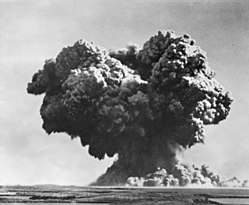Operation Hurricane

Operation Hurricane was the test of the first British atomic bomb. The device tested was a plutonium implosion bomb intended to be as close a copy to the Fat Man weapon as possible but improved by using a levitated pit. Although increasing the power of the bomb, this was actually done to allow the pit to be inserted into the weapon shortly before detonation as a safety measure. There were concerns that without the gap between the tamper and the pit, a criticality accident could occur.
The bomb used plutonium produced at Calder Hall in Cumbria (now Sellafield) with a low Pu-240 content since hurried production led to short irradiation times. In fact Windscale could not quite meet the 1 August 1952 deadline for manufacturing the core and the device also used some Canadian-supplied plutonium.
To test the effects of a ship-smuggled bomb (a threat of great concern to the British at the time), Hurricane was exploded inside the hull of HMS Plym (a 1,370-ton River-class frigate) which was anchored in 12 m of water 350 m off shore. The explosion occurred 2.7 m below the water line, and left a saucer-shaped crater on the seabed 6 m deep and 300 m across.
|
Time |
00:00 on 3 October 1952 (GMT), 08:00 on 3 October 1952 (WAST) |
|
Location |
Off Trimouille Island, one of the Monte Bello Islands, Australia, 20°25′S, 115°33′E |
|
Test Height and Type |
Ship, -2.7 m |
|
Yield |
25 Kt |
